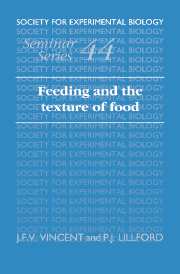Book contents
- Frontmatter
- Contents
- List of contributors
- Introduction
- Mechanical and fracture properties of cellular and fibrous materials
- Texture of plants and fruits
- Measuring meat texture and understanding its structural basis
- Food processing by mastication in cyprinid fish
- Quantitative aspects of the relationship between dentitions and diets
- The control of movements and forces during chewing
- The basic mechanics of mastication: man's adaptive success
- Integrating texture and physiology – techniques
- Brittle textures in processed foods
- The control and generation of texture in soft manufactured foods
- Texture and acceptability of human foods
- Index
Mechanical and fracture properties of cellular and fibrous materials
Published online by Cambridge University Press: 14 January 2010
- Frontmatter
- Contents
- List of contributors
- Introduction
- Mechanical and fracture properties of cellular and fibrous materials
- Texture of plants and fruits
- Measuring meat texture and understanding its structural basis
- Food processing by mastication in cyprinid fish
- Quantitative aspects of the relationship between dentitions and diets
- The control of movements and forces during chewing
- The basic mechanics of mastication: man's adaptive success
- Integrating texture and physiology – techniques
- Brittle textures in processed foods
- The control and generation of texture in soft manufactured foods
- Texture and acceptability of human foods
- Index
Summary
Most foods, natural or manufactured, have structures which are either cellular or fibrous or both. Meat, fish and poultry owe their distinctive texture to the fibrous nature of the muscles and to the way in which they fracture with fibre separation. The crispness of fresh fruit and vegetables is a consequence of having moderately large cells filled with liquid, pressurised by osmotic turgor and adhering to each other. On being bitten or chewed the cells can either rupture, releasing their contents as in a crisp apple, or separate from each other as in a mealy apple. When significant amounts of fibres or fibre bundles are also present, as in asparagus or spinach for example, the texture of the cooked vegetable is affected considerably and the material is perceived as tough because of the difficulty in breaking the fibres. Extrusion-cooked products are often designed to be heterogeneous so as to introduce desirable textural attributes; this can be achieved, for example, by producing cellular structures where cell size and cell wall thickness can be varied.
The perception of food texture depends on specific properties of the food materials themselves (resistance to deformation and fracture, appearance, taste, etc.) and on the interactions between the mouth and the foods through teeth, muscles, taste buds, etc. (Williams & Atkin, 1983). Biting and mastication in particular play a central role in determining the acceptability of foods and this chapter concentrates on the mechanical properties of food materials relevant to these aspects. The elastic, strength and fracture properties of heterogeneous substances will be reviewed and discussed in relation to those textural attributes which depend on them.
- Type
- Chapter
- Information
- Feeding and the Texture of Food , pp. 1 - 18Publisher: Cambridge University PressPrint publication year: 1991
- 6
- Cited by



